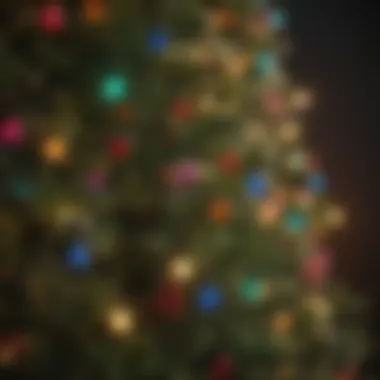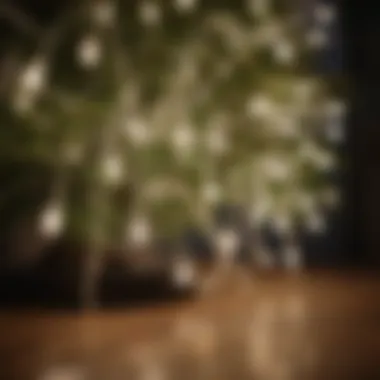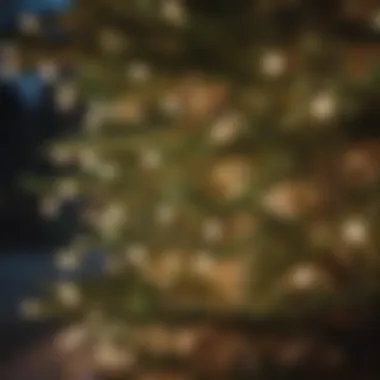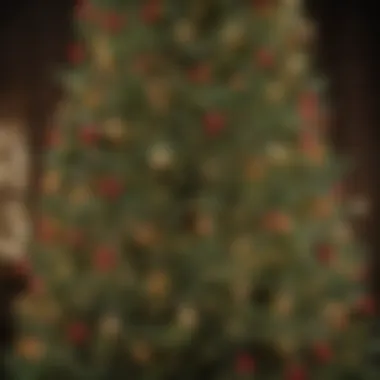String Lights on Christmas Trees: A Complete Guide


Intro
String lights have evolved from mere decorations to quintessential components of holiday aesthetics, especially when adorning Christmas trees. The whimsical glow they provide can transform a tree into a captivating centerpiece. Understanding how to select and arrange these lights is beneficial for anyone looking to enhance their festive decor. In this guide, we will explore various elements related to string lights, covering practical tips, design techniques, and crucial safety considerations.
With so many options available, homeowners, interior design enthusiasts, and party hosts alike can benefit from a thorough understanding of how to best utilize string lights. This overview will pave the way for a delightful and sophisticated holiday experience.
Key Insights and Trends
As we step into the festive season, certain trends emerge in how string lights are used. These trends often align with broader currents in interior design, reflecting both personal preferences and collective tastes. Understanding these nuances can significantly enhance the visual appeal of your Christmas tree.
Current Trends in Interior Design
- Minimalism
Minimalism continues to make a mark, with homeowners opting for understated elegance. Simple string lights, perhaps with a soft white hue, can provide a serene charm that complements minimalist decor. - Eco-Friendly Options
Sustainability is increasingly important. LED string lights, particularly those powered by solar energy, are popular choices for environmentally conscious decorators. - Mixed Styles
Mixing modern and traditional styles creates a unique aesthetic. Incorporating vintage or colored string lights with a contemporary tree design has become a favored approach.
Popular Gardening Techniques of the Season
Seasonal gardening techniques can also influence how string lights are arranged on trees. For instance, using lights to illuminate natural elements like branches or wreaths can create an organic, rustic feel.
Practical Tips and How-To Guides
To achieve the desired look for your Christmas tree and ensure effective use of string lights, follow these practical guidelines.
Step-by-Step Guides for Home Decoration Projects
- Select Appropriate Lights: Choose between warm white or colored string lights based on your overall theme.
- Measure Tree Height: Determine how many strands you will need. A good rule is 100 lights per vertical foot of tree.
- Start From the Base: Begin wrapping lights around the trunk and move outward to the branches. This method creates depth.
- Layer Lights: Use multiple strands in varying thicknesses for visual interest.
- Include Other Decorations: Incorporate ornaments and garlands after setting the lights for a balanced look.
Entertaining Tips and Planning Checklists
- Create a Theme: Define a color scheme or design theme ahead of time.
- Safety Check: Ensure all electrical components are up to date and safe for use.
- Plan Lighting Schedule: Consider using timers for convenience and energy efficiency.
- Engage Family: Make decorating a family activity. Each person can contribute by placing lights in a specific area of the tree.
"Adequate planning can vastly improve both the decoration process and the enjoyment of the holiday season."
By adhering to these practices, you can transform your Christmas tree into an enchanting display that reflects your personal style and festive spirit.
Prelude to String Lights
String lights have become a definitive feature in holiday decorations, particularly on Christmas trees. They provide not just illumination, but also enhance the visual appeal and create a festive atmosphere. Understanding how these lights evolved, alongside the variations available in the market, helps to make informed choices. Choosing the right string lights can transform a simple tree into a captivating centerpiece. This article will guide you through essential aspects of string lights, ensuring a well-rounded decorating experience for your holiday season.
History of String Lights
The history of string lights dates back to the early 20th century. Initially, the concept began with incandescent bulbs, which were introduced to the public as a safe alternative for use in homes. In 1882, Thomas Edison was one of the pioneers of electric light displays. This innovation laid a foundation for what would eventually evolve into the string lights we use today.
Over the decades, string lights became synonymous with festive occasions. During the holidays, these lights helped create warmth and ambiance. Their evolution from simple white bulbs to a varied palette of colors reveals society's shifting aesthetic preferences. Nowadays, string lights are available in various styles, accommodating diverse tastes and decorating schemes.
Types of String Lights Available
When it comes to selecting string lights for your Christmas tree, understanding the types available is crucial.
Incandescent Lights
Incandescent lights have been a popular choice for many years. Their warm glow gives a classic ambiance that many associate with holiday traditions. One key characteristic of incandescent lights is their simplicity. They are easy to find and usually affordable.
However, they do have some disadvantages. These lights tend to consume more power compared to their LED counterparts, leading to higher electricity bills. Their heat production can also be a concern, especially when used extensively on a Christmas tree. Overall, incandescent lights remain a charming choice but come with trade-offs to consider.


LED Lights
LED lights are becoming the preferred option for modern holiday decorators. Their significant contribution to energy efficiency cannot be overlooked. LED technology uses much less energy while producing amazing brightness.
This type of light can often last longer than incandescent varieties, making them a cost-effective and appealing choice. Another unique feature is their versatility. They come in various colors, shapes, and sizes. However, some people find LED lights to be less warm-toned than traditional incandescent bulbs, which may not suit everyone's taste.
Battery-Operated Lights
Battery-operated lights offer a flexible decorating solution for spaces without easy access to electrical outlets. A key characteristic of these lights is their portability. They can be placed anywhere, making them perfect for unique tree layouts.
This type of lighting also provides a gentle ambiance that can be appealing. On the downside, battery-operated options may require frequent battery changes, especially if used for extended periods. The range of available lighting designs can vary, impacting visual cohesion with other decorations on the tree.
When selecting string lights, consider both aesthetic preference and practical implications.
Choosing the right string lights for your Christmas tree is essential for elevating your holiday décor. Each type offers unique features that cater to different tastes and needs.
Selecting the Right String Lights for Your Tree
Choosing the right string lights is essential for creating an inviting and visually stunning Christmas tree. Not only do the right lights enhance the overall aesthetic, but they also tie together the different features of your tree and decorations. With many options available, selecting lights based on specific factors can greatly influence the holiday atmosphere in your home.
Consider Your Tree Size
The size of your Christmas tree is a fundamental aspect to consider when selecting string lights. A larger tree will require a more substantial number of lights to avoid looking sparse. Conversely, smaller trees may only need a few strands to achieve a lovely effect.
For a standard 6 to 7-foot tree, experts suggest using around 100 lights per vertical foot. Therefore, for a tree that measures 7 feet, you’d likely need 700 lights for even coverage.
Additionally, consider the thickness of your tree. A full tree may benefit from more lights to showcase its layers properly. In contrast, a slimmer tree might not need as many lights to maintain the aesthetic appeal.
Light Color and Brightness
Light color can dramatically change the mood of your holiday decor. You have several choices, with the two primary categories being warm and cool tones.
Warm vs. Cool Tones
Warm tones, typically around 2700-3000 Kelvin, emit a soft, yellowish-white light. This choice contributes to a cozy and inviting ambiance, making it ideal for families looking for a traditional holiday vibe.
On the other hand, cool tones, typically above 4000 Kelvin, create a bright, clean look with a bluish tint. While cool lights can flatter modern decorations, they may lack the warmth that some associates with holiday cheer. Warm lights are a popular choice, as they tend to bring out the richness of ornaments and greenery.
Key characteristic of warm tones: Their soft glow complements traditional decor and creates an intimate atmosphere.
Unique feature of cool tones: They provide a contemporary style often associated with winter themes, but they can feel stark if overused.
Multicolored Options
Multicolored string lights add a playful and festive touch to your tree. This option allows for a wide variety of combinations, from classic red and green to more modern schemes.
The key characteristic of multicolored lights is their versatility. They can brighten any space and appeal to those who enjoy a playful aesthetic, capturing the light-heartedness of the season.
However, a potential disadvantage is that they can sometimes overshadow ornaments or decorations, especially on a more traditional tree with a muted color palette.
Length and Spacing of Lights
The length and spacing of your string lights also matter. Lights that are too closely spaced can create a cluttered look, while lights that are too far apart may fail to highlight the tree’s beauty effectively. It is essential to find a balance.
As a guideline, you might use about 6 to 12 inches of space between each light. This allows for an even glow that enhances the overall appearance. When measuring the necessary length, consider the limbs and overall design of your tree to avoid running short or having excessive slack.


When properly selected, string lights can showcase your tree’s beauty and enhance your holiday experience significantly. In the next sections, we will explore design techniques and safety considerations to ensure a successful and enjoyable decorating process.
Design Techniques for Draping String Lights on Christmas Trees
Draping string lights on Christmas trees is a fundamental element of holiday decor. It allows homeowners to elevate the visual appeal of their trees, creating a warm and inviting atmosphere. The method of arranging these lights can significantly impact the overall aesthetic. Focusing on specific techniques can bring depth, enhance features, and add a personalized touch to your festive display. Understanding these design techniques not only contributes to the beauty of the tree but also ensures that the lighting setup complements other decorations.
Layering Lights for Depth
Layering lights is a technique that adds dimension to a Christmas tree. By using multiple strands of lights, you can create a rich visual texture. Begin with a base layer of lights, your main source of illumination. This could be a standard warm white or a soft color to provide an overall glow. On top of that, add another layer of lights, possibly using brighter or multicolored options.
This method gives the tree a more three-dimensional appearance. A combination of lights at different distances from the tree can play with shadows and highlights, making the decorations pop. It's helpful to step back and observe the tree from different angles while arranging the lights. This technique allows for modifications and ensures you achieve the desired effect.
Wrapping vs. Draping Lights
Deciding between wrapping and draping string lights boils down to the effect you wish to create. Wrapping lights around the branches involves encasing them closely around the limbs of the tree. This method provides a more concentrated glow and can accurately highlight the structure of the foliage. It is perfect for creating a clean look on sparsely decorated trees.
On the other hand, draping lights across branches gives a softer appearance. This technique allows lights to cascade downwards or hang loosely from branches, enhancing fluidity. The draping technique works well on fuller trees, as it creates interesting shapes and patterns without overpowering the overall look. A combination of both methods can also be effective.
Highlighting Specific Tree Features
Every tree has its unique characteristics. Perhaps it has a particularly beautiful branch or a section adorned with favorite ornaments. Using string lights strategically can draw attention to these features. For instance, wrapping lights around a prominent branch can emphasize its shape and size. You can also position lights closer to certain decorations to make them stand out.
Utilizing different light colors is another way to enhance specific areas. Consider using brighter lights or a different color to spotlight certain sections of the tree. This not only showcases the tree’s beauty but also adds an element of surprise for viewers.
Safety Considerations When Using String Lights
When it comes to decorating Christmas trees with string lights, safety should be a paramount concern. Given that these lights are often used near flammable materials like tree branches and ornaments, understanding safety protocols can prevent accidents and enhance enjoyment during the festive season. The main goal is to create a warm atmosphere without posing risks. Key considerations include checking electrical standards, avoiding overloads, and ensuring the materials used can withstand heat.
Electrical Safety Guidelines
String lights can pose various electrical hazards if not used properly. Homeowners must ensure that they only use lights that have been tested and certified by recognized safety organizations. Look for labels from Underwriters Laboratories (UL) or a similar entity. These certifications are signs that the product meets safety standards.
Inspect the total wattage of lights, especially if multiple sets are connected. Overloading can lead to overheating, which is a fire risk. A good practice is to keep lights on for shorter periods, particularly when unattended. Additionally, check for frayed or damaged cords upfront. If any damage is found, replacing the string lights may be safer than attempting repairs.
- Use lights designed for indoor use if placed inside the house.
- Avoid using extension cords unless they are rated for outdoor use when necessary.
- Follow the manufacturer’s guidelines regarding connections and the number of sets that can be linked together.
Fire Resilience and Appropriate Materials
Beyond electrical safety, understanding how materials used in string lighting contribute to fire safety is critical. String lights should ideally be constructed from materials that are inherently fire-resistant. This means that when buying lights, consumers should look for features that emphasize flame retardance.
Also, decorations surrounding the lights matter. For example, tinsel or certain types of ornaments may be more vulnerable to catching fire. It’s prudent to evaluate the type of foliage used on trees, ensuring that it is fresh and has not dried out, as dried branches and leaves can ignite quickly.
Investing in quality lights and being aware of the surroundings minimizes potential hazards during the holiday season.
In summary, focusing on safety considerations when using string lights is essential. Adhering to electrical safety guidelines and ensuring the resilience of materials can drastically reduce risks, allowing homeowners to celebrate without fear. Preparing adequately ensures that the holiday experience remains joyful and secure.
Integrating String Lights with Other Decorations
Integrating string lights with other decorations enhances the overall aesthetic of your Christmas tree. It shifts the focus from the lights alone to the broader holiday decor. By combining different elements, you create a harmonious visual experience. Consider how string lights complement various ornaments, tinsel, foliage, and ribbons. This integration adds depth and richness to your display, making it feel more curated and intentional.
When integrating string lights, think about balance and harmony. Choose decorations that match the color themes of the lights. The right combination will elevate your design, creating a cohesive visual narrative.
Complementing Ornaments and Tinsel


Ornaments and tinsel are essential components of any Christmas tree decoration. String lights can enhance these features by providing illumination that draws attention to their details. For instance, warm white lights might highlight the warmth of glass ornaments, while sparkling tinsel can catch the light from LED strings brilliantly.
Arrange your ornaments thoughtfully, placing larger and more colorful ones closer to the bottom. This positioning allows the lights to accentuate the ornaments, providing a background glow that enhances their visual impact. Similarly, tinsel can be artfully draped between branches, reflecting light and creating a subtle glimmer. Careful planning ensures the tree looks festive from every angle.
Using Foliage and Ribbons
Natural elements such as foliage, along with ribbons, introduce texture and color variety. They can soften the appearance of string lights, making the overall design more inviting. When intertwined with string lights, foliage adds life and movement to the tree, enhancing its festive charm.
Ribbons, in particular, can have dramatic effects when combined with string lights. For example, using sheer or metallic ribbons in a contrasting color with your string lights can create stunning visual contrasts. Drape the ribbons in loose loops or cascading strands down the tree. This technique helps to break the monotony of string lights and introduces a dynamic flow throughout the tree.
Creating Layered Lighting Effects
Layered lighting effects add complexity to your Christmas tree design. By combining string lights of varying brightness and colors, you can create focal points and areas of interest. For instance, use bright lights at the top to draw the eye upward, while softer, warmer lights can fill the lower branches.
Additionally, consider mixing white lights with colored options for a festive atmosphere. This practice allows you to emphasize different areas of the tree, guiding the viewer's gaze and creating a sense of depth. Moreover, using lights with different functions, such as twinkling or fading effects, can further enhance this engaging visual experience.
Effective integration of string lights not only beautifies the tree but also transforms the overall room's atmosphere, adding warmth and joy to the holiday season.
By understanding how to integrate string lights with other decorations, you can achieve a thoughtful, visually striking Christmas tree that captures the spirit of the season.
Maintenance and Care for String Lights
Caring for string lights is a crucial part of ensuring they maintain their functionality and visual appeal year after year. Proper maintenance will not only prolong the life of the lights but also enhance their performance. Given the holiday season's heavy use of decorations, it is vital to integrate effective care practices into your annual routine.
Storing String Lights Post-Holiday
After the festive season, many homeowners overlook the importance of proper storage. Storing string lights correctly can prevent tangling and breakage. Here are some practical tips for effective storage:
- Use a Reel or Container: Wrapping lights around a storage reel or placing them in a sturdy container can keep them untangled and organized.
- Avoid Excessive Bending: Ensure that the lights are not bent or twisted too sharply. Sharp bends can lead to wire breakage and malfunctioning bulbs.
- Cool, Dry Environment: Store lights in a cool, dry space to avoid moisture damage. Humidity can corrode electrical components.
- Check for Damage: Before storage, examine the lights for any wear or damage. This will ensure you do not bring out faulty lights next year.
Troubleshooting Common Issues
Even with proper care, string lights might encounter problems. Familiarizing yourself with common issues and their resolutions can save time and frustration.
- Bulbs Not Lighting Up: Often, this results from a burned-out bulb. Check each one individually, replacing any dead bulbs to restore functionality.
- Power Supply Problems: Ensure the outlet is functioning. Testing with another appliance can verify if the problem lies with the lights or the source.
- Flickering Lights: This could indicate a loose connection. Inspect the entire strand for loose bulbs or connections and secure them.
- Short Circuits: If your lights stop working unexpectedly and emit a burnt smell, unplug them immediately. This may indicate a short circuit, requiring consultation with a professional.
Maintaining your string lights through proper storage and troubleshooting can enhance your holiday decorations for years to come. Consider regular check-ups as part of your decor routine, prioritizing safety and efficiency with each use.
Closure: Elevating Your Holiday Experience
In the realm of holiday decor, string lights serve as a vital element, transforming the ordinary into the extraordinary. The use of string lights on Christmas trees is not just about adding brightness; it is about creating an ambiance that reflects the spirit of the season. This section summarizes the key takeaways from the comprehensive guide, emphasizing the multifaceted benefits of integrating string lights into your festive traditions.
Reflecting on Your Decor Choices
When decorating your Christmas tree, every choice counts. It is essential to reflect on the types of string lights that align with your overall aesthetic. Whether you lean towards warm white LED lights that evoke a cozy atmosphere, or prefer multicolored lights that shout celebration, each decision is significant.
Consider the themes and colors that resonate with you and your family. Perhaps you could opt for a nature-inspired palette, incorporating green and gold lights intertwined with natural elements like pine cones and foliage. Alternatively, a modern look might call for sleek, minimalist decorations paired with clear string lights. By selecting the right combinations, your tree can truly exhibit your personal style.
- Take time to step back and view your work.
- Adjust lighting placements until they work seamlessly in your chosen design.
- Think about how your tree can capture special memories and traditions.
Encouraging Creativity in Future Seasons
The holiday season provides a perfect canvas for creativity. Each year presents an opportunity to experiment with your lighting design. As you plan for next Christmas, reflect on your experiences with string lights. Think about what worked and what could be improved.
Innovation can thrive in the choice of lights and arrangements. Try using solar-powered lights or smart string lights that change colors based on your preferences, which can enhance interaction with your decor.
Encourage family and friends to join in the decorating process. Their unique ideas could breathe fresh life into your annual traditions. Embrace the joy and creativity that string lights bring, allowing this festive activity to become a cherished ritual.
As you sit back and admire your finished tree, remember that your design choices contribute to the larger holiday experience. The glimmer of lights can ignite joy and nostalgia, forging lasting memories for all who gather around.
"Great decor does not happen by accident; it results from thoughtful planning and a dash of imagination."
In navigating seasonal trends in lighting, your exploratory spirit can lead to innovative designs that truly elevate your holiday experience. Engage with resources online at platforms such as Wikipedia, Britannica, and communities on Reddit or Facebook for inspiration.
This guide has aimed to provide not just practical advice but also to inspire creativity and thoughtful decor choices for your Christmas trees. Embracing the art of string lighting can infuse warmth and joy into your home, ensuring your festive celebrations are memorable.



